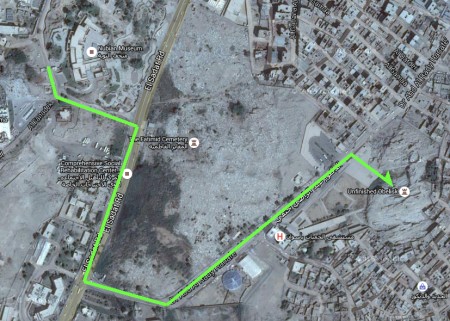
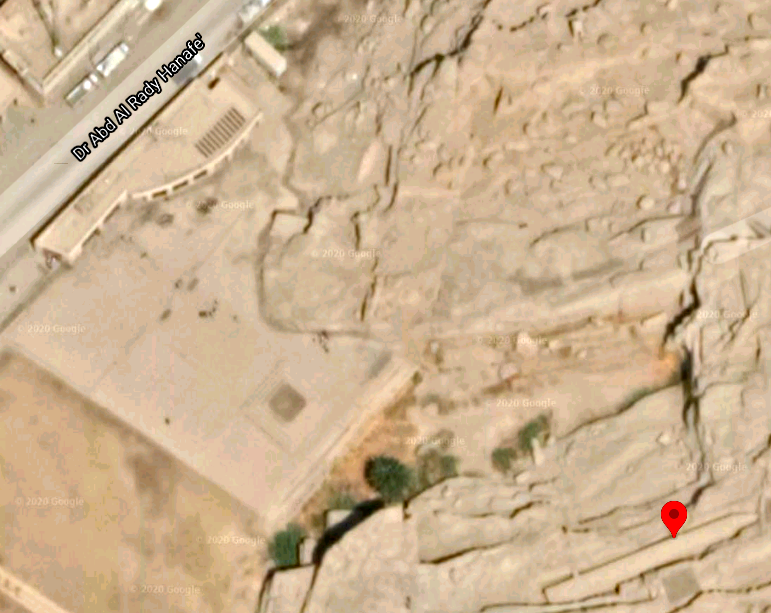
|
| |
 | |
 |
Unfinished Obelisk
| Present Site: | Aswan, Egypt N 24°04'36.9"(24.076920) E 32°53'43.8"(32.895490) |
| Pharaoh: | Unknown |
| Measurement: | About 42 meters long [Source: Estimate by Reginald Engelbach, See below.] |
| Stone: | Red granite |
About The Site:
This "unfinished" obelisk, or "under quarrying" obelisk is lying at a former ancient Egyptian quarry in the rock mountain of red granite, which is located off the south from the city of Aswan.
Today, the entire rock mountain is surrounded by the fences and it is maintained as an open air museum.
How To Get There:
Since to the unfinished obelisk site is located off the south from the city of Aswan (see Google Map at right), taking a taxi would be recommended. It would be a good idea that visiting both here and the Nubian Museum on one route. Alternatively we can walk from the Nubian Museum in about 20 minutes, but walking in April to October would have to be avoided as it's very hot in daytime. The walking route from the Nubian Museum is shown at right. After coming out of the Museum, turn left, then turn left again after 500 meters, then go down the slope, we can reach the unfinished obelisk site.
The admission fee was 50 EGP when I visited here in 2016. Taking pictures is allowed, but the extra fee is necessary for using a tripod.
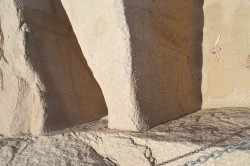 The bottom and the apex are still connected to the bedrock. |
About The Obelisk:
Although it may be difficult to image from only the words of "unfinished obelisk", but this is an obelisk abandoned on the way of being cut out from the bedrock at a stone quarry. We can see it with the satellite picture of Google Map (lower right), but this may be hard to understand how big it is. If you compare the vehicles (in small white things) running on the road, you would easily understand the huge size of it.
This site is one of the quarries for the red granite. Looking at the satellite picture, we can confirm the many rectangular traces which quarried out the stone materials.
The obelisk is in the process of being carved out from the bedrock, the surroundings of the obelisk are being dug down, but the bottom and apex are still connected to the bedrock. The reason for being abandoned was that the huge crack appeared during the process to remove the block of stone from its bedrock.
The crack is well-understood if you see the picture shooted from the upper side at bottom on this page. Many obelisks that can be seen now are repairing with adhering the broken fragments, but in the ancient Egypt, one perfect monolith was used for the obelisk, not using such a construction method. Hence, if the crack was appeared in the middle of carving works, they had to abandon it.
This obelisk was studied in detail in 1921 and 1922 by British Egyptologist Reginald Engelbach, and those outcomes were reported in the book "The problem of the obelisks, from a study of the unfinished obelisk at Aswan" (1923). According to this, the existence of this "unfinished obelisk" was know for many centuries. However the academic excavation study on this obelisk would never done until 1922, and the photographs in the midst of buried sand also remain.
This book describes in detail about the method of quarring out the obelisk, transportation method, how to be erected etc. We can often see the descriptions how to quarry out the obelisk, but many of those were based on this Reginald Engelbach's book. The reprinted edition of this book is available through Amazon.com and others, and also a pdf version can be downloaded at free from the New York University's website and others.
Reginald Engelbach estimates its length is about 42 meters, and weight is 1,168 tons. If this has been safely extracted and erected, it should have been the biggest one as the ancient obelisk.
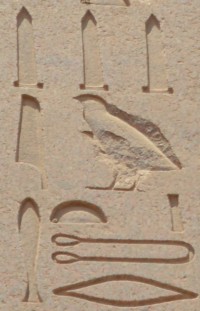 Inscription including three obelisks |
Who Ordered This Obelisk: According to the Wikipedia page on this obelisk, this concluds that Queen Hatshepsut ordered. This story is widely known in fact, and it seems that the Egyptian local guide also explains that Queen Hatshepsut ordered it. However, I believe that the Hatshepsut Theory is only one of the possibilities.
What is the basis of the Hatshepsut Theory is the inscription on the east side of Obelisk of Queen Hatshepsut in the Temple of Amun in Karnak. That inscription says, "In addition to the two great obelisks, it must repeat building the obelisks [or monuments] (plural) further for living forever", and three obelisks are drawn at the word of "further" (see picture at left). However, since the obelisks that actually Queen Hatshepsut erected afterward in the Temple of Amun was two, and remaining another one obelisk would might have ended as "unfinished", would be estimated.
There are various versions of translated English text of this inscription. Two obelisks are drawn at the word of "two great obelisks" in every version, However even three obelisks are drawn on the inscription, the every translated English text simply says "monuments", not the number of "3". This is slightly curious. Even if Queen Hatshepsut wanted to make three obelisks, it would be a short-circuiting decision that this [unfinished obelisk] is the remaining one obelisk.
Reginald Engelbach illustrates two kinds of plans in his book, and he points the size of the smaller one is equivalent to Lateran Obelisk, and for the another one, he indicates the possibility of Thutmose III, but as a conclusion, he avoids the assertion. The bottom right picture is a copy of the illustration which shows two plans in his book.
Also, Willia Budge introduces this Unfinished Obelisk in his book "Cleopatra's Needles and Other Egyptian Obelisk", but he doesn't state the name of Queen Hatshepsut. In anyway, we should be aware that the academic books don't assert this is of Queen Hatshepsut.
However, it's also a fact that many large obelisks were made in the reign of Queen Hatshepsut and Thutmose III, so many theories idicate it's an obelisk of this age. Besides, there would be possibilities that Amenhotep III and Ramses II who liked big buildings, ordered the production of this obelisk. Either way, it is impossible unless Egypt is prospering, for doing such a large construction work. Hence, it's reasonable thought that this would be a ruin in the 18th Dynasty to the 19th Dynasty in the New Kingdom era, or 16th to 12th Centuries BC.
Notes For Pictures:
Even if the photograph of lying obelisk is taken by standing on the ground, it's hard to understand the whole image of the obelisk. As an aerial photo, although the image that seems to be taken more than 10 years ago is often posted on the websites. but I don't know what is the original. Among them, I'd like to refer to the website of "Ashtronort-History's Mysteries". Many sightseer are on the obelisk. We can understand the size of obelisk when comparing with the size of people who are standing on the obelisk.
It is ideal to take pictures with a drone, but since the use of drone is strictly prohibited in Egypt, when my visit in 2016, I tried to take pictures with using 5-meter long selfie camera stick. The shadow of the camera attached to the stick is appearing in the picture (below left) of the upper side of the obelisk.
|
Shooting from the upper side |
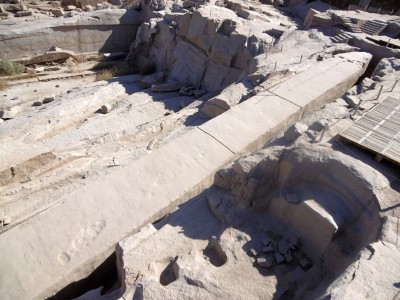 Shooting from the lower side |
Illustration by Reginald Engelbach |
|||
April 29, 2016 by Hiroyuki Nagase (For high definition image, please click the picture) | |||||
Copyright Hiroyuki Nagase nagase@obelisks.org and Shoji Okamoto okamoto@obelisks.org